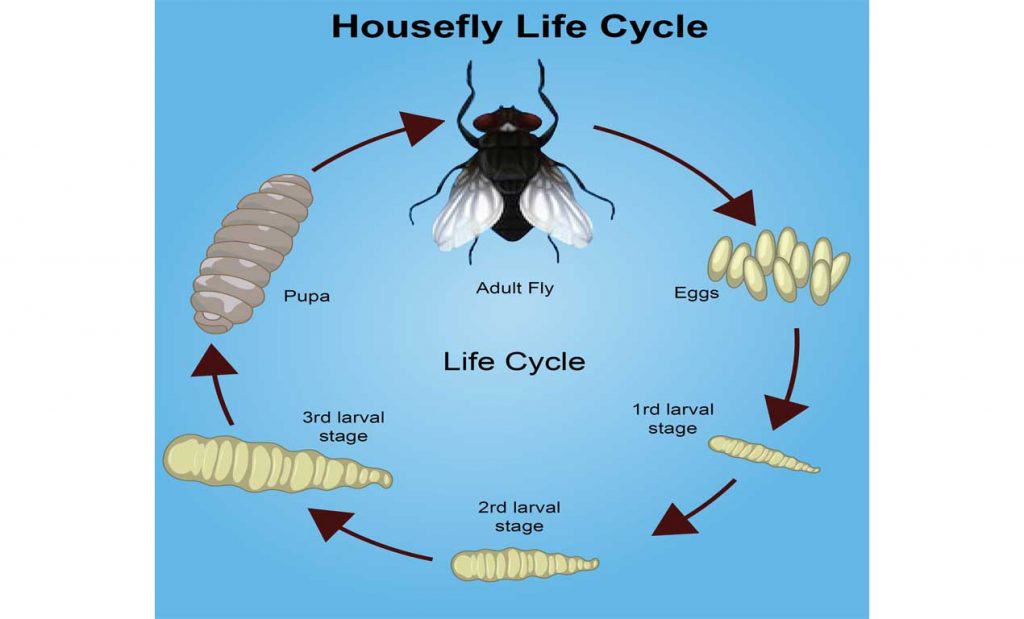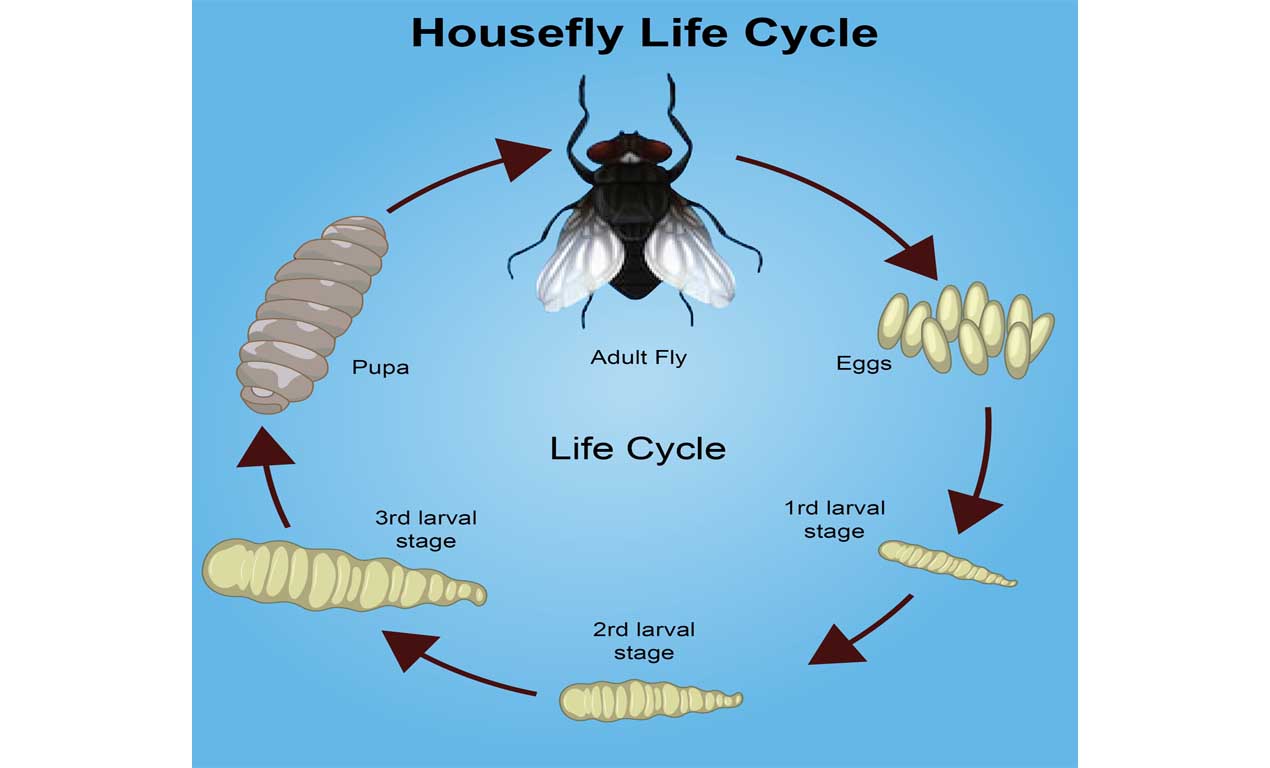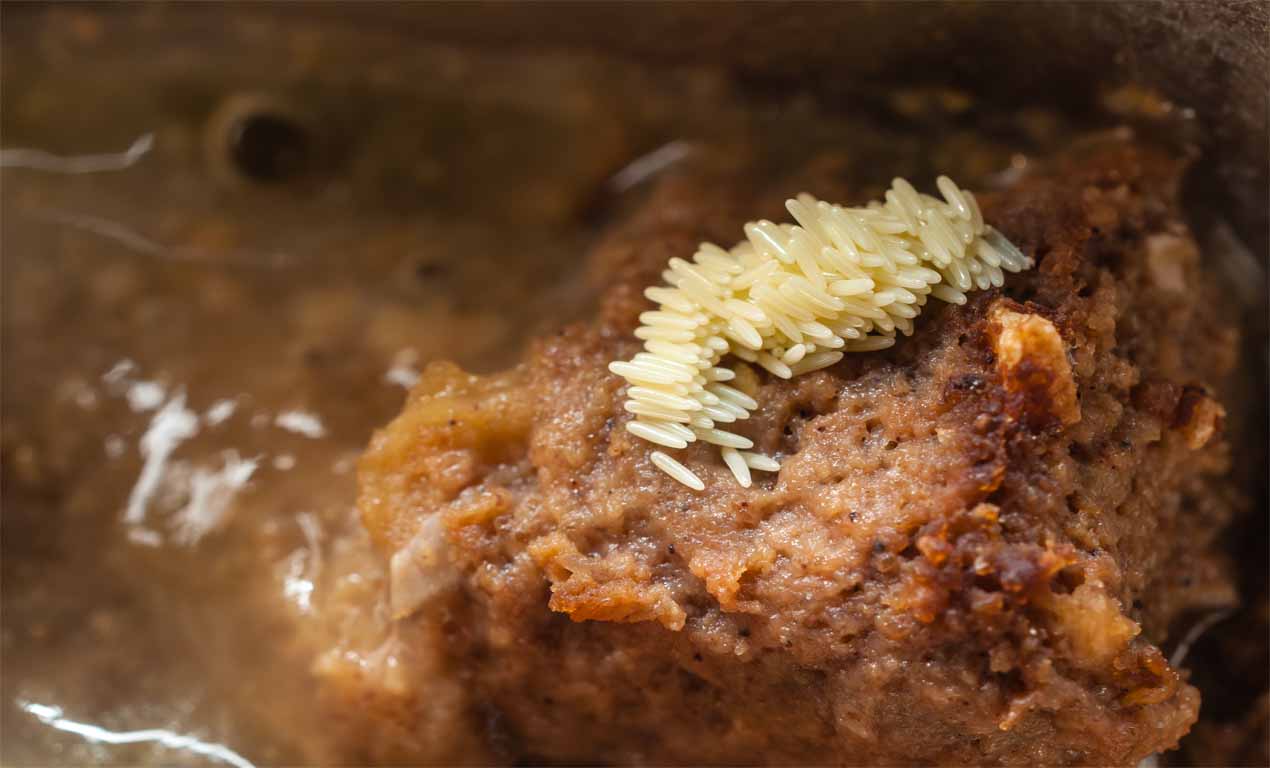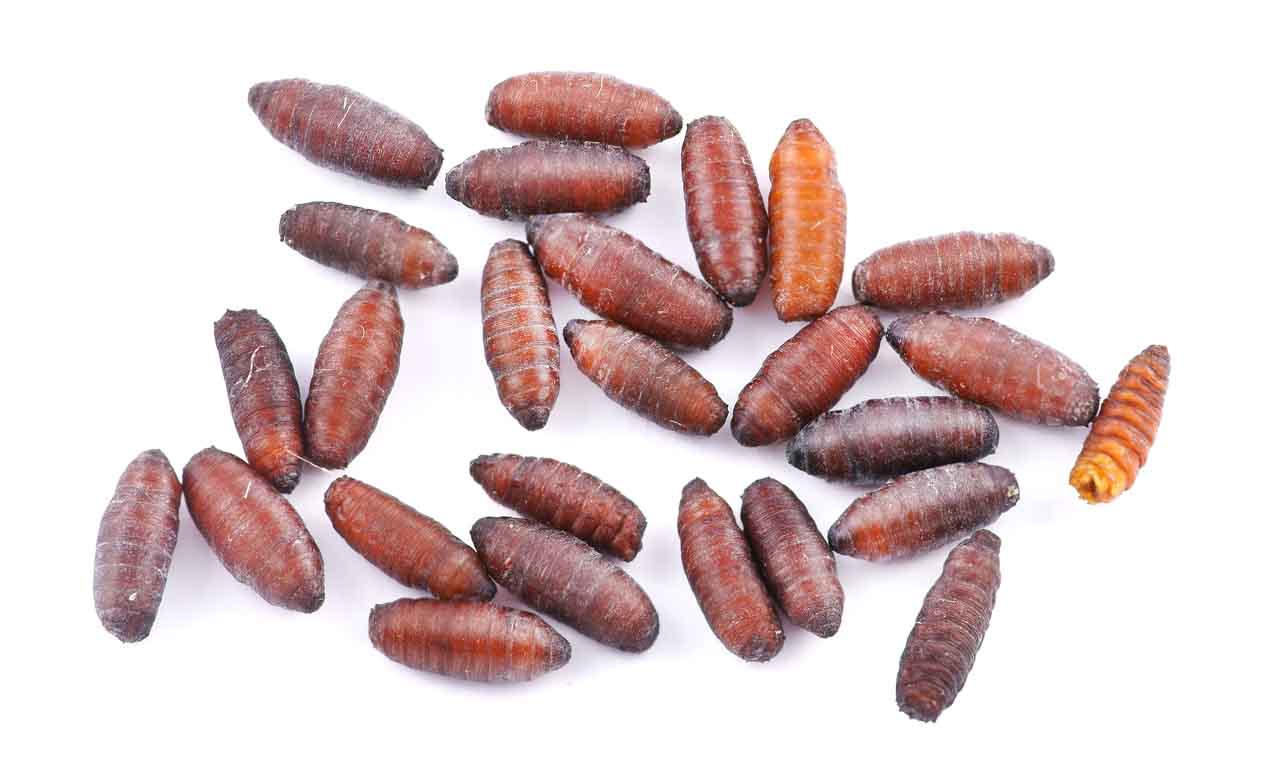
 Houseflies are of the suborder, Cyclorrhapha and Diptera order. These are the most common flies found in our homes, and they get located across the world. The adult flies are black to grey, with four dark lines across their thorax. They have little hair on their bodies and have a single pair of membranous wings to fly. Houseflies have red compound eyes and are set apart in females.
Houseflies are of the suborder, Cyclorrhapha and Diptera order. These are the most common flies found in our homes, and they get located across the world. The adult flies are black to grey, with four dark lines across their thorax. They have little hair on their bodies and have a single pair of membranous wings to fly. Houseflies have red compound eyes and are set apart in females.
So, what is housefly lifecycle in brief? Housefly mainly evolves through 4 stages i.e., eggs, larva, pupa, and then adult fly. It takes about 8 to 20 hours for the eggs to hatch, and it takes about 12 days to fully mature. There are three larval stages. Stage one is after it hatches, then stage two after that stage three.
Continue reading to know in detail.
Little Bit About Housefly
They are active during spring, summer, and the rainy season. They are diurnal and rests at night. Houseflies get known as human pests since they are a carrier of serious diseases. They carry dangerous pathogens on their bodies and infect human food. They pick up this disease-causing bacteria from garbage, feces, and open wounds.
Houseflies are always looking for a conducive place to lay their eggs. It could be any excreta, garbage, rotting vegetation, or human waste. Since they have a very short life-cycle, they are always busy feeding and procreating. Twelve generations of houseflies get created annually in temperate regions, while twenty new generations get created in tropical climates.
Body Structure
 Houseflies are around 6 to 7mm in length. They have a sizeable frontal head, tapering into a cone. Their compound eyes are large, and they almost touch in males. The female’s body is more significant, while the male has longer legs. They have three simple ocelli in front and a pair of small and mobile antennas. They process visual information seven times quicker than humans. Hence, they get to see movement quite early to make good their escape!
Houseflies are around 6 to 7mm in length. They have a sizeable frontal head, tapering into a cone. Their compound eyes are large, and they almost touch in males. The female’s body is more significant, while the male has longer legs. They have three simple ocelli in front and a pair of small and mobile antennas. They process visual information seven times quicker than humans. Hence, they get to see movement quite early to make good their escape!
Mouthparts: Their mouthparts have a retractable and flexible proboscis, ending with fleshy tip, labellum. This sponge-like labellum has many grooves, thro’ which they secrete saliva like digestive juice to soften the food. They use their capillary action to suck up the liquefied and softened food.
Chemoreceptors: They have chemoreceptors on the tarsi or underside of their legs. This helps them identify their food source just by walking over them. They clean their legs sometimes so that they get to taste different food with this receptor.
Legs: Houseflies’ legs end with a pair of claws and a sticky pad. When they walk on slippery surfaces, including vertical walls and ceiling, these adhesive pads grip the surface, and the claws get used to loosening the pads so that they could walk. Flies always have three legs on the surface, while the other three legs are on the air. When they land on any surface, their front legs take the impact, before the hind four legs lands on the surface.
Thorax: The head of flies get attached to the thorax, which is of three segments. You have the prothorax, mesothorax, and the metathorax. Their color varies between grey and black, and their body has short hairs. The wing has a translucent yellowish tinge at the base, where it gets attached to the mesothorax. The hind wing is a short haltere, which helps them to balance while in flight. Each thoracic segment bears a pair of lateral legs. Spiracles are present in the prothorax, close to the base of the wings.
Abdomen: The abdomen of houseflies has ten segments. The first segment does not get developed. The second, sixth, seventh, eighth, ninth, and tenth segments are tiny. Segments third to fifth are regular, and females have their ovipositor in these, which helps her in reproduction. In males, the last section bears the genitalia, and the ninth segment has the clasper pairs, which get used to holding on to the female during copulation.
The spiracles are present in all the abdominal segments in houseflies, through which it breathes. The tenth pair of both the sexes have the anal cerci, which gets used to pass the waste mater of feces.
Some Interesting Facts
Habitat: They live near human settlements – in their houses, gardens, ranches, and farms.
Evolution: The true flies are pre-historic creatures. However, the houseflies are relatively new, and are in existence after the dinosaur era!
Multiplication: Under suitable conditions, houseflies breed quickly, and the females lay their eggs multiple times.
Flight: Houseflies don’t fly far. They beat their wings quickly to create the buzzing sound, but are slow. Since they live in human habitat, they have enough space to forage for food and procreate.
Filth: Houseflies love trash. They breed rapidly in human and animal waste, rotting vegetation, garbage sites, and stagnant sewage locations.
Liquid food: They cannot feed on solid food since their mouthparts can only suck liquid or semi-solid food. In case they come across a tasty snack that is solid, they vomit a digestive juice on the food, liquefies the same, and laps it up.
Taste receptors: These taste receptors get located near the lower part of the houseflies’ legs. When they land on any food item, they can identify which is tasty enough for them to feed on.
Diseases: Since they thrive on filth, it’s easy for them to pick up disease-causing bacteria from any of these sites on to your food. They are known to spread diphtheria, typhoid, cholera, dysentery, leprosy, and conjunctivitis.
Acrobatics: Houseflies can walk upside down due to the sticky pads on their feet. They land on a hard surface with their forelimbs, absorb the impact, and then quickly bring down the other four. If they descend at an angle, they quickly maneuver and settle down upright.
Poop: They excrete in abundance, in direct proportion to their feeding habit.
Life Cycle
Sexual maturity:The male fly reaches sexual maturity in 16 hours after emerging from the pupa. While the female is mature only after 24 hours. Females release a pheromone, which is a cuticular hydrocarbon. This does not get released in the atmosphere but gets identified by males when they come in contact with their bodies.
Courtship:The male initiates a mating cycle by bumping into the female housefly, either airborne or on the ground. This gets to be known as ‘strike.’ He climbs up to her thorax, and if she is receptive, courtship follows. The female flutters her wings, and the male, in turn, strokes her head.
Mating:The male quickly positions himself in front of her abdomen, and the female pushes her ovipositor towards his genital area for the sperm. Copulation occurs, and the sperm takes a couple of minutes to get transferred to the female.

Eggs:The female mates only once, while the male mates multiple times. After four to five days after copulation, the females start to lay her eggs. The females secrete a volatile semiochemical, that attracts other female flies. They lay their eggs singly but in clusters. Each female houseflies can lay up to 500 eggs during her lifetime. In every batch, she lays around 75-100 eggs. She lays her eggs in four to six installments. The eggs must have surrounding moisture to hatch.
The eggs are shiny white and get laid in the waste matter, feces, rotting food, and other dead or decaying substances. The females do not take care of the eggs or the young ones. They ensure that the place the eggs get laid has enough nutrition for the larvae to feed. The eggs are about 1mm long, slightly curved or elliptical shaped, with one end somewhat broader than the other. There are two longitudinal ribs across the egg surface, like thickened ridges. The larvae hatch through a slit along the entire length of the egg case.

Larva: The eggs get hatched into little larvae in a day, which requires the right temperature and environment to grow. If the eggs hatch in fresh swine or chicken manure, the larvae quickly develop into a pupa. While the larval growth on cattle, goats, or horses is slower, it takes a more extended period to get into the pupae stage, and also pupae size is smaller. In some conditions, the eggs do not hatch at all. The entire period from larvae to pupa stage takes around ten days in optimal conditions. In adverse situations, it can extend up to two months.
The freshly hatched larvae are around 2mm long and are white, soft, long, and cylindrical shaped. This headless creature is known as a grub. On end is the thin tapered mouth opening, while it is thicker toward its rear end. Their exoskeleton gets covered with cuticles. Their mouthpart has a black hook-like chitinous mandibular projection. This helps them to feed and tear, and also to move forward.They feed on decomposing waste, where they hatch. They avoid light and grow faster inside the protective covering of decaying matter, which warm, moist, and dark.
The larval phases are known as instars. They have three stages of instar larvae. The freshly hatched larvae are in its first instar. Within the next two to three days, they undergo their first molt and enter the second instar. After another two to three days, they experience the second molting and enter the third instar.

Pupa: After the third instar larvae stage, they crawl to a dry spot and turns into a pupa. Their last shed body gets used to form the pupal case, which is cylindrical and rounded ends. The pupa is around 6mm long. They do not have a mouth or anus, and hence they do not eat. They breathe thro’ the spiracles. Initially, it is yellowish, and with the passing time, it turns to red, brown, and finally black.
It completes its transformation in two to six days at 35-degree temperature. Takes a more extended period of 20 days or more, if the temperature is colder. The entire development into a housefly – every section, appendages including the wings, occurs within the pupal case.
Adult: When the metamorphosis is complete, the adult emerges from the pupa. To appear, the fly uses its ptilinum on its head to break open one end of the pupal case. This fluid-filled bump with which the adult breaks open to emerging, deflates and quickly vanishes.
The freshly liberated housefly is colorless, and its wings are small and immobile. Their exposure to the atmosphere brings in their body color and also strengthens the wings.
The adult fly lives for two weeks to a month in the wild. They cease to grow once they emerge out of the pupal case. Smaller flies could be either malnourished or a different species of fly. In 15 to 20 hours, they are ready to reproduce themselves.
Conclusions
The life cycle of a housefly is very similar to most insects. You have the eggs, followed by the larvae, pupa, and then the adult stage. The period between fertilized eggs to the adult stage is seven to ten days under suitable conditions. Within a day, they attain sexual maturity. Houseflies live for around one month.
Males can copulate multiple times during their lifetime with different female houseflies. Females copulate only once and stores the sperm in her ovipositor. She lays around 500 eggs during her lifetime. The eggs get laid in 4 to 6 installments in a conducive environment for them to hatch and larvae to get their nourishment.
Welcome to my blog. I have been doing pest control for years since my house, garden and pets were always attacked by various kinds of pests and as a result I had to know proper pest control techniques that works. In this blog I share all the tips and tricks that I know and I hope you’ll find it helpful.
